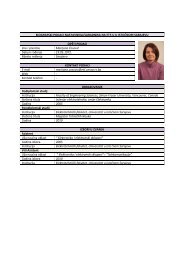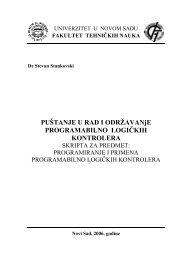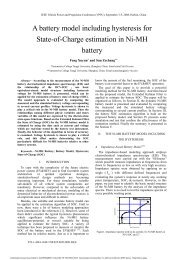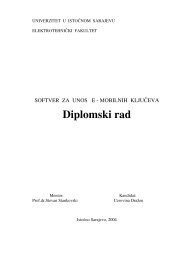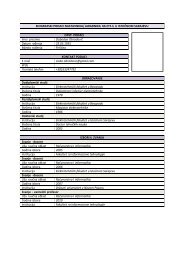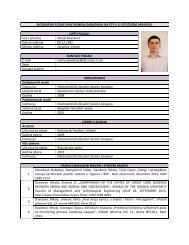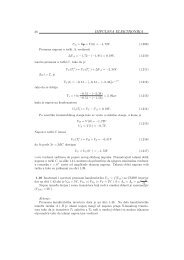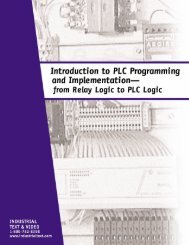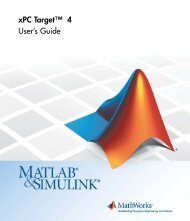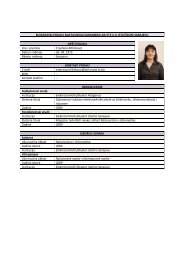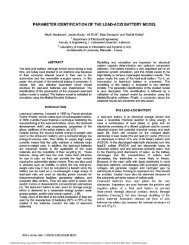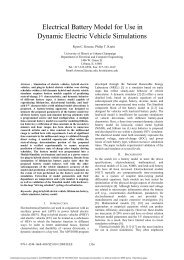New dynamical models of lead-acid batteries - Power Systems, IEEE ...
New dynamical models of lead-acid batteries - Power Systems, IEEE ...
New dynamical models of lead-acid batteries - Power Systems, IEEE ...
Create successful ePaper yourself
Turn your PDF publications into a flip-book with our unique Google optimized e-Paper software.
CERAOLO: NEW DYNAMIC MODELS OF LEAD–ACID BATTERIES 1189<br />
Fig. 7. Comparison <strong>of</strong> simulated and measured battery voltage during charge<br />
(battery 2).<br />
Again, a good agreement <strong>of</strong> simulated and measured curves is<br />
shown, although the model shows some difficulty <strong>of</strong> integration<br />
when the battery is nearly full.<br />
V. CONCLUSION<br />
Fig. 6. Comparison <strong>of</strong> simulated and measured battery voltage for a<br />
constant-current discharge up to 1.75 V followed by a period in which the<br />
current is constantly null.<br />
In Fig. 6 the simple transient constituted by a constant-current<br />
discharge up to a element voltage equal to 1.75 V followed by a<br />
period in which the current is constantly null is considered. In all<br />
the plots the voltage <strong>of</strong> a single battery element, both simulated<br />
and measured are shown.<br />
Fig. 6(a) and (b) refer to battery 1. The current is equal to<br />
58 A for a duration <strong>of</strong> 8.6 h, then it is 0.<br />
Fig. 6(c) and (d) refer to battery 2. The current is equal to<br />
63 A for a duration <strong>of</strong> 7.2 h, then it is 0.<br />
Both figures show a good agreement <strong>of</strong> measured and simulated<br />
shapes.<br />
For battery 2, the model is checked also during the charge<br />
process. The comparison <strong>of</strong> measured and simulated voltage<br />
for a 53 A charge (starting from a completely empty battery)<br />
is shown in Fig. 7.<br />
• The complex, nonlinear behavior <strong>of</strong> electrochemical <strong>batteries</strong><br />
can be conveniently modeled using equivalent electric<br />
networks. Although these networks contain elements<br />
that are nonlinear and depend on battery state-<strong>of</strong>-charge<br />
and electrolyte temperature, they are very useful for the<br />
electric engineer, since they allow to think in terms <strong>of</strong> electric<br />
quantities, instead <strong>of</strong> internal battery electrochemical<br />
reactions.<br />
• The third-order model proposed has an accuracy satisfactory<br />
for the majority <strong>of</strong> uses; for particular situations<br />
more sophisticated <strong>models</strong> can be derived from the general<br />
model structure proposed in the paper.<br />
• The proposed model can be used for several purposes; the<br />
more important fields <strong>of</strong> application are:<br />
— computer simulation <strong>of</strong> battery behavior under different<br />
operating conditions (possibly containing both<br />
charge and discharge processes);<br />
— management <strong>of</strong> on-line systems containing electrochemical<br />
<strong>batteries</strong>: state-<strong>of</strong>-charge estimation, battery<br />
monitoring and diagnostics; estimate <strong>of</strong> residual range<br />
<strong>of</strong> electric vehicles [12], [15].<br />
• The use <strong>of</strong> the proposed <strong>models</strong>, in particular the thirdorder<br />
formulation, is complicated by the fact that the proposed<br />
equations contain several parameters that have to be<br />
identified. This identification can however be simplified a<br />
lot since some <strong>of</strong> the parameters can be taken as constant<br />
for all the <strong>batteries</strong> built with the same technology.<br />
APPENDIX<br />
MODEL PARAMETERS USED FOR SIMULATIONS<br />
TABLE I<br />
PARAMETERS OF BATTERY 1(ONLY PARAMETERS NEEDED FOR<br />
DISCHARGE SIMULATIONS)<br />
Authorized licensed use limited to: GOVERNMENT COLLEGE OF TECHNOLOGY. Downloaded on June 22,2010 at 10:31:37 UTC from <strong>IEEE</strong> Xplore. Restrictions apply.



